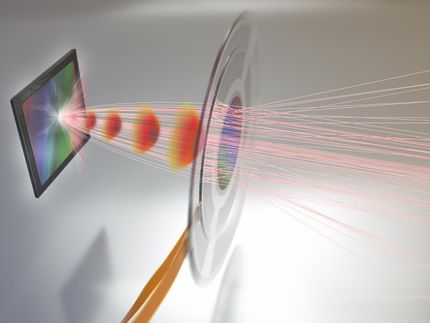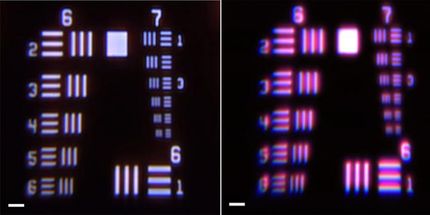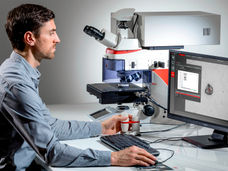Flat lens opens a broad world of color
Last summer, researchers at the Harvard John A. Paulson School of engineering and Applied Sciences (SEAS) announced a new, flat lens that could focus light with high efficiency within the visible spectrum. The lens used an ultrathin array of nanopillars to bend and focus light as it passed.

SEAS researchers have developed the first flat lens that works within a continual bandwidth of colors, from blue to green. This bandwidth, close to that of an LED, paves the way for new applications in imaging, spectroscopy and sensing.
Image courtesy of Vyshakh Sanjeev/ Harvard SEA
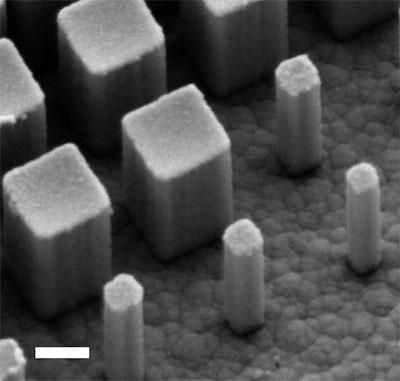
A scanning electron microscope image shows a side-view of the metalens, with nanopillars optimized to focus colors without chromatic dispersion. Scale bar: 200 nm.
Image courtesy of the Capasso Lab/Havard SEAS

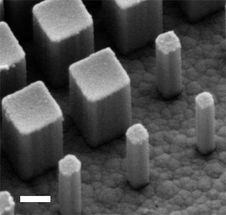
The announcement was hailed as a breakthrough in optics and was named among Science Magazine's top discoveries of 2016.
But the lens had a limitation - it could only focus one color at a time.
Now, the same team has developed the first flat lens that works within a continual bandwidth of colors, from blue to green. This bandwidth, close to that of an LED, paves the way for new applications in imaging, spectroscopy and sensing.
One of the major challenges in developing a flat, broadband lens has been correcting for chromatic dispersion, the phenomenon where different wavelengths of light are focused at different distances from the lens.
"Traditional lenses for microscopes and cameras -- including those in cell phones and laptops -- require multiple curved lenses to correct chromatic aberrations, which adds weight, thickness and complexity," said Federico Capasso, Robert L. Wallace Professor of Applied Physics and Vinton Hayes Senior Research Fellow in Electrical Engineering. "Our new breakthrough flat metalens has built-in chromatic aberrations corrections so that a single lens is required."
Correcting for chromatic dispersion -- known as dispersion engineering -- is a crucial topic in optics, and an important design requirement in any optical systems that deals with light of different colors. The ability to control the chromatic dispersion of flat lenses broadens their applications and introduces new applications that have not yet been possible.
"By harnessing chromatic aspects, we can have even more control over the light," said Reza Khorasaninejad, a Research Associate in the Capasso Lab and first author of the paper. "Here, we demonstrate achromatic flat lenses and also invent a new type of flat lens with reverse chromatic dispersion. We showed that one can break away from the constraints of conventional optics, offering new opportunities only bound by the designer's imagination."
To design an achromatic lens -- a lens without chromatic dispersion -- the team optimized the shape, width, distance, and height of the nanopillars that make up the heart of the metalens. As in previous research, the researchers used abundant titanium dioxide to create the nanoscale array.
This structure allows the metalens to focus wavelengths from 490 nm to 550 nm, basically from blue to green, without any chromatic dispersion.
"This method for dispersion engineering can be used to design various ultrathin components with a desired performance," said Zhujun Shi, a PhD student in the Capasso Lab and co-first author of the paper. "This platform is based on single step lithography and is compatible with high throughput manufacturing technique such as nano-imprinting."
Harvard's Office of Technology Development has filed patent applications on a portfolio of flat lens technologies and is working closely with Capasso and members of his research group to catalyze commercialization of this technology through a startup company.
Original publication
Other news from the department science
These products might interest you
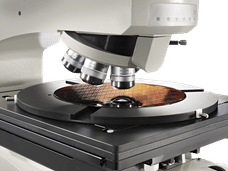
DM8000 M & DM12000 M by Leica
See More, Detect Faster
High-throughput Inspection Systems
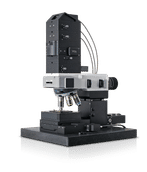
alpha300 R by WITec
3D Raman microscopes with unequalled speed, sensitivity and resolution
Visualize and characterize every chemical detail
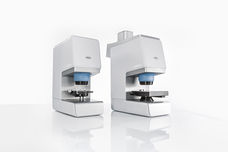
LUMOS II by Bruker
FT-IR microscopy in the fast lane - the LUMOS II
One infrared microscope for all

ZEISS ZEN core by Carl Zeiss
ZEISS ZEN core - Your Software suite for connected microscopy in laboratory and production
The comprehensive solution for imaging, segmentation, data storage and analysis

HYPERION II by Bruker
FT-IR and IR laser imaging (QCL) microscope for research and development
Analyze macroscopic samples with microscopic resolution (5 µm) in seconds

Get the chemical industry in your inbox
By submitting this form you agree that LUMITOS AG will send you the newsletter(s) selected above by email. Your data will not be passed on to third parties. Your data will be stored and processed in accordance with our data protection regulations. LUMITOS may contact you by email for the purpose of advertising or market and opinion surveys. You can revoke your consent at any time without giving reasons to LUMITOS AG, Ernst-Augustin-Str. 2, 12489 Berlin, Germany or by e-mail at revoke@lumitos.com with effect for the future. In addition, each email contains a link to unsubscribe from the corresponding newsletter.
Most read news
More news from our other portals
See the theme worlds for related content
Topic World Spectroscopy
Investigation with spectroscopy gives us unique insights into the composition and structure of materials. From UV-Vis spectroscopy to infrared and Raman spectroscopy to fluorescence and atomic absorption spectroscopy, spectroscopy offers us a wide range of analytical techniques to precisely characterize substances. Immerse yourself in the fascinating world of spectroscopy!

Topic World Spectroscopy
Investigation with spectroscopy gives us unique insights into the composition and structure of materials. From UV-Vis spectroscopy to infrared and Raman spectroscopy to fluorescence and atomic absorption spectroscopy, spectroscopy offers us a wide range of analytical techniques to precisely characterize substances. Immerse yourself in the fascinating world of spectroscopy!
Topic World Chromatography
Chromatography enables us to separate, identify and thus understand complex substances. Whether in the food industry, pharmaceutical research or environmental analysis - chromatography opens up a treasure trove of information about the composition and quality of our samples. Discover the fascinating world of chromatography!

Topic World Chromatography
Chromatography enables us to separate, identify and thus understand complex substances. Whether in the food industry, pharmaceutical research or environmental analysis - chromatography opens up a treasure trove of information about the composition and quality of our samples. Discover the fascinating world of chromatography!
